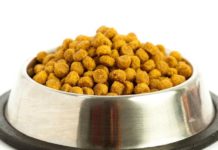
Are preservatives in dog food the evil culprit behind the long list of medical issues our four-legged family members now face? Food allergies, environmental allergies, kidney disease, immunodeficiency, and cancer are all on the rise and many dogs owners do not blame the actual food as much as they blame the preservatives in the dog food but are they right? Can food preservatives cause this myriad of issues?
Why are there Preservatives in your Dog Food?
Like humans, dogs do require a limited amount of fat in their diet so commercial dog foods include a percentage, usually between 12 and 30%, of added fat. It is the fat in dog food is the only nutrient prone to spoiling although preservatives do increase the shelf life and freshness of the average bag of dog food increasing their shelf life. Without any preservatives, dog food would go rancid much faster, lowering shelf life and potentially becoming a danger to your pet!
Canned dog food, however, is preserved by the packaging process so if you read a list of chemicals and preservatives in the ingredient list, be warned!
Natural & Unnatural Preservatives in Dog Food
Not all preservatives in dog food are created equal however. To begin with, preservatives are divided into two groups – natural and artificial or unnatural.
Natural preservatives in dog food and most often include tocopherols (vitamin E) and ascorbic acid (vitamin C).
The list of artificial preservatives in dog food is longer and includes but not limited to butylated hydroxytoluene (BHT), butylated hydroxyanisole (BHA) and ethoxyquin. Of all the artificial preservatives, ethoxyquin is the one that causes the most amount of concern.
Ethoxyquin is an antioxidant found most often in pet food as well as spices to prevent colors fading due to oxidation of the natural carotenoid pigments. Although it has been found to be fatal in fish, the long terms effects in dogs is largely unknown. Although the current legal limit of ethoxyquin in pet food is set at 150 ppm (0.015%), the US Food and Drug Administration (FDA) has requested pet food manufacturers to voluntarily limit their use to 75 parts per million as it has been found to increase the build up of protoporphyrin IX in the liver as well as increase levels of liver-related enzymes in some animals. The consequences relating to the animal’s health of these problems are unknown at this time.
BHT and BHA are synthetic analogues of vitamin E and are listed under the Generally Recognized as Safe (GRAS) by the FDA. They are some of the most common preservatives found in human food however there is some speculation regarding these preservatives of late as potential carcinogens. Animal studies have shown, however, that they actually protect against cancer if they are ingested prior to the animal being exposed to the carcinogen. Until more research is done however, there are currently no health concerns surrounding the use of BHT and BHA in dog food.
Natural preservatives in dog food are not as effective at preventing rancidity as their artificial counterparts but concern over their inclusion is less as well. Mixed tocopherols supply dog food with vitamin E while cranberries, blueberries, apples, and other fruit provide vitamin C. Citric acid and rosemary, an evergreen shrub with antioxidant properties, are often used in dog food as well.
Are Preservatives in Dog Food Necessary?
The shelf life of a bag of dog food varies from manufacturer to manufacturer but average six months to a year. Once the bag is opened, however, the expected freshness is usually under ninety days with many manufacturers recommending half the food be placed in the freezer once the bag is opened. Manufacturers also recommend that the food is kept in the bag (versus putting it into a separate container) as preservatives leach into the plastic lining of the bag, helping it stay fresher for longer.
The solution? Only purchase enough food for what your dog is able to consume in the given time frame. For example, a five-pound Chihuahua can only eat less then a quarter pound day so buying a 40-pound bag would mean that the food would be rancid by the time he got even half way through the bag. It is better for your pet, and your pocket book, to buy a twenty-pound bag and putting part of it in the freezer.
Ask your veterinarian or speak with a veterinary nutritionist if you have questions or concerns about the quality of the food you are feeding your pet and research the various common ingredients in foods so you know what you are feeding your pet.
Good health starts with good quality food and ensuring your pet is eating the very best food helps guarantee his long-lasting health!





